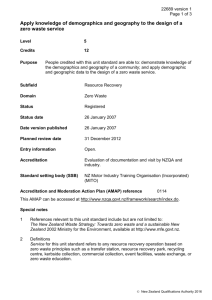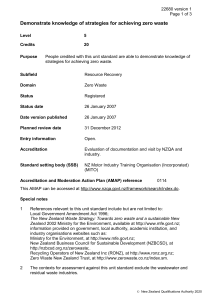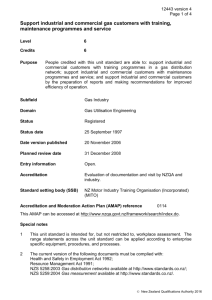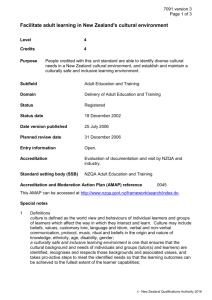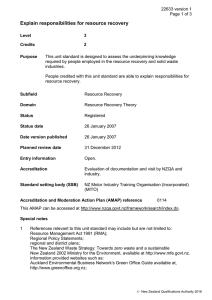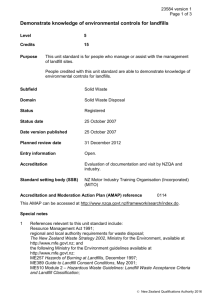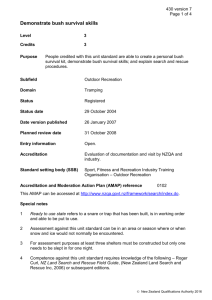22677 Discuss key concepts of zero waste theory and practice
advertisement
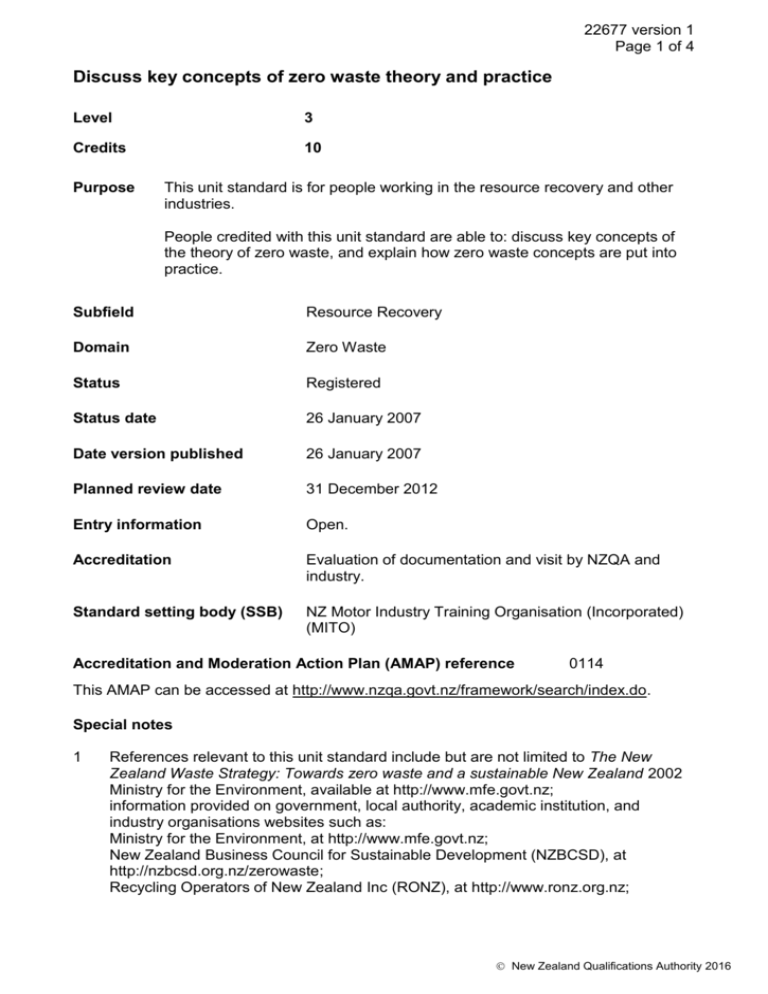
22677 version 1 Page 1 of 4 Discuss key concepts of zero waste theory and practice Level 3 Credits 10 Purpose This unit standard is for people working in the resource recovery and other industries. People credited with this unit standard are able to: discuss key concepts of the theory of zero waste, and explain how zero waste concepts are put into practice. Subfield Resource Recovery Domain Zero Waste Status Registered Status date 26 January 2007 Date version published 26 January 2007 Planned review date 31 December 2012 Entry information Open. Accreditation Evaluation of documentation and visit by NZQA and industry. Standard setting body (SSB) NZ Motor Industry Training Organisation (Incorporated) (MITO) Accreditation and Moderation Action Plan (AMAP) reference 0114 This AMAP can be accessed at http://www.nzqa.govt.nz/framework/search/index.do. Special notes 1 References relevant to this unit standard include but are not limited to The New Zealand Waste Strategy: Towards zero waste and a sustainable New Zealand 2002 Ministry for the Environment, available at http://www.mfe.govt.nz; information provided on government, local authority, academic institution, and industry organisations websites such as: Ministry for the Environment, at http://www.mfe.govt.nz; New Zealand Business Council for Sustainable Development (NZBCSD), at http://nzbcsd.org.nz/zerowaste; Recycling Operators of New Zealand Inc (RONZ), at http://www.ronz.org.nz; New Zealand Qualifications Authority 2016 22677 version 1 Page 2 of 4 Sustainable Households and Sustainable Living, at http://www.sustainablehouseholds.org.nz, link to issues; Waste Management Institute of New Zealand (WasteMINZ) at http://www.wasteminz.org.nz/; Zero Waste New Zealand, at http://www.zerowaste.co.nz/index.sm. 2 Assessment for this unit standard includes the protection of water resources but excludes practices for dealing with wastewater. Elements and performance criteria Element 1 Discuss key concepts of the theory of zero waste. Range examples given to illustrate the theory may be historical and/or current. Performance criteria 1.1 The discussion outlines the changing relationship over time between natural resources and their use by humans in terms of sustainability. Range 1.2 The discussion establishes national and local effects of zero waste policy and practice and describes them in terms of their interconnection. Range 1.3 short and long term effects on two sources of pollution. The discussion defines the term ‘closing the loop’, and describes key pathways for achieving zero waste. Range 1.5 effects – environmental, social, cultural, economic. The discussion identifies and describes zero waste principles in terms of their short term and long term effects on pollution. Range 1.4 use – local, national, global; includes but is not limited to – traditional and contemporary Māori and other cultural perspectives. key pathways include but are not limited to – design, production, consumption cycle, waste hierarchy, resource efficiency. The discussion explains the concept of ‘think global and act local’ in relation to the workplace. New Zealand Qualifications Authority 2016 22677 version 1 Page 3 of 4 Element 2 Explain how zero waste concepts are put into practice. Performance criteria 2.1 The explanation identifies and illustrates governmental and nongovernmental strategies for expanding the application of zero waste principles. Range 2.2 The explanation identifies the main types of organic and inorganic resources and describes strategies for reducing their disposal and/or recovering their components. Range 2.3 government and nongovernment – local, national, international; strategies include but are not limited to – policy, legislation, regulation, incentives, penalties. three organic, five inorganic. Current systems for implementing zero waste are identified in relation to the workplace. Range at least two of – kerbside recycling, resource recovery centres, event recycling, education programmes, one other. 2.4 The explanation outlines a simple waste audit in relation to a workplace. 2.5 The explanation outlines zero waste practices relating to consumer and household choices. Range 2.6 The explanation identifies and outlines zero waste practices for travel and tourism. Range 2.7 four choices. three choices. The explanation identifies barriers to implementing zero waste principles in the candidate’s environment and suggests feasible solutions for the present and/or future. Range at least two barriers from – financial, social, cultural, educational, legal. Please note Providers must be accredited by the Qualifications Authority, or an inter-institutional body with delegated authority for quality assurance, before they can report credits from assessment against unit standards or deliver courses of study leading to that assessment. Industry Training Organisations must be accredited by the Qualifications Authority before they can register credits from assessment against unit standards. New Zealand Qualifications Authority 2016 22677 version 1 Page 4 of 4 Accredited providers and Industry Training Organisations assessing against unit standards must engage with the moderation system that applies to those standards. Accreditation requirements and an outline of the moderation system that applies to this standard are outlined in the Accreditation and Moderation Action Plan (AMAP). The AMAP also includes useful information about special requirements for organisations wishing to develop education and training programmes, such as minimum qualifications for tutors and assessors, and special resource requirements. Comments on this unit standard Please contact the NZ Motor Industry Training Organisation (Incorporated) (MITO) info@mito.org.nz if you wish to suggest changes to the content of this unit standard. New Zealand Qualifications Authority 2016
